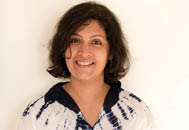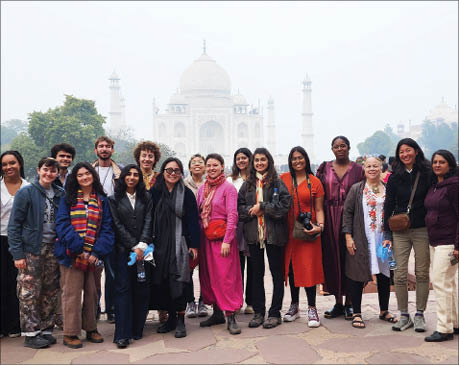A couple has founded Direct Create, a platform that connects local artisans to a network of designers and buyers to collaborate a handcrafted life across the world.
Sheela Lunkad is a trained architect with more than two and a half decades of experience in the spheres of craft development, community empowerment, and design-led businesses. She, along with Rajeev Lunkad, has founded Direct Create, which is a platform that connects local artisans to a network of designers and buyers to collaborate and co-create a handcrafted life across the world.
The India Sensed Programme is a project run by Direct Create, where students from the school travel to India to work with local artisans and explore the country’s rich cultural heritage. The underlying goal is to provide students with a transformative experience, to create new, meaningful works of art, and to promote sustainable livelihoods for local artisans.
In this interview, Sheela Lunkad talks about the creative vision behind Direct Create, the recent visit of the Rhode Island School of Design (RISD) students as part of the India Sensed Programme, and culture and heritage as a representative of India’s soft power, among other things.
Excerpts
Q1. What’s the creative vision behind Direct Create?
A. Direct Create was founded with the singular vision of creating a handcrafted ecosystem of makers, designers, and markets that can connect, collaborate, and cement products and services.
Q2. Rhode Island School of Design (RISD) students recently visited India as part of the India Sensed Programme. What is the mission of the programme?
A. For years, there has been a desire to share our cultural heritage and knowledge systems with designers across the globe. I have had the good fortune to have met, lived with, interacted with, engaged with, and created with hundreds of artisans and craftspeople across India for over three decades. In all my experience, I feel nothing is dying or endangered—what is lacking and causing the drain in this community is a lack of new design ideas and new markets that can evolve and grow. This is only possible if the markets have the know-how and are able to experience the sheer joy and beauty that are possible when designers, consumers, and artisans meet to collaborate and co-create. With this burning thought, we helped conceptualise and curate the programme in early 2022. Catherine Andreozzi and Joy Ko are the professors for apparel and textile design at RISD, and they suggested a travel class for their winter semester, which is the norm, but the students had never been to India before. The idea behind the India Sensed Programme was to sense India, its sights, sounds, smells, people, and culture, engage with craftsmanship, and see how it helps connect to their individual creativity.

Q3. What all do you offer to the visiting participants under the India sensed programme?
A. The India sensed programme had a mix of historical walks through the cities of Delhi, Agra, and Jaipur with experts and scholars, including a visit to the national museum and the crafts museum at Pragati Maidan. There is nothing more nourishing than having an enriching understanding of society and civilization through the prism of history and how it has shaped modern times.
Q4. How do you look at culture and heritage as representatives of India’s soft power?
A. Culture is what we all have inherently encoded in our psyches. It is a way of life, and we can choose to embrace the diversity of individual and collective cultural identity if we so wish. Today, we are global and local at the same time, and it is in our shared experiences that I believe. When communicated with empathy, they can bring people across the world closer together. When we spend time travelling, interacting, and exchanging ideas with people in different parts of the world, we are all imbibing a bit of each other and allowing for mutual respect. Only when we experience knowing can we understand, and only then can we accept and appreciate the differences of human civilization. Man as a social being has become extremely divisive and self-sufficient, and I believe sharing cultural knowledge and identifying with it is probably one of the fastest ways to bring peace and harmony to the world of today.
Q5. How can Indian students benefit from the programme? Do you have any specific plans for the future?
A. Indian students can greatly benefit from an understanding of and exposure to craftsmanship and its journey in the digital world. India has an extremely rich cultural heritage, which can best be felt as an experience. Merely reading or seeing videos of villages and people weaving or printing cannot convey the entire spectrum of richness that a travel and experiential workshop can bring to the senses. Every school and college should have modules that allow the kids to engage with our design and cultural heritage. It is especially necessary for the youth of India to understand this in today’s world, as they are the people who are going to populate and create the next digital evolution. If they understand the beauty and joy of what the human hand can create and feel it in all their cells, they may choose to recreate that magic in the cloud world, and that is precious.
Q6. What’s next on your itinerary?
A. Our company DCBV in Amsterdam is in talks with design schools and institutions in the Netherlands that are working towards sustainable living and creative exploration with craftspeople in India. There is immense value in handcraft and human connection. Personal experiences and shared cultural journeys bring people closer together. When people engage in the act of creation, all the senses are captured and harnessed by the power to be able to bring in harmony, beauty, and love, which is a necessary ingredient in the world of today.
We plan to work with institutions across the world to map the web of stories and crafted traditions that exist in different cultures and how they influence creative thought processes. Creative engagement using sensory perceptions of time and place, delving into layers of memories and traditions that inform the hand and the brain, creating new patterns and impulses, and thereby bringing joy and life to all the participants, is what we envision.

